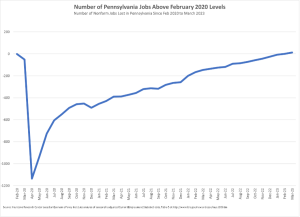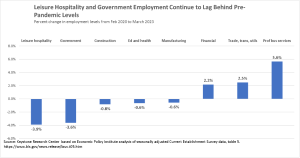It has been just over three years since the onset of the COVID-19 pandemic. The just-released March jobs report for Pennsylvania indicates that our labor market, like the nation’s, has now fully recovered to pre-pandemic levels. Our state now has more non-farm jobs than it ever has. Unemployment was 4.2% in March of 2023 in Pennsylvania, well below the 4.6% average in our state in the 12 months before the pandemic. Alongside the full recovery of the job market, the annual (12-month average) inflation rate in the United States fell to 5% in March.
Looking in more detail at the last month of economic data, Pennsylvania added 12,500 jobs in March 2023, reaching a record high of 6,108,900 jobs.

While above the national rate of 3.5%, Pennsylvania’s 4.2% unemployment was lower than in any month since June 2000.

Our labor force participation rate (not shown in a chart) has now climbed back within a percentage point of the pre-pandemic (February 2020) level of 62.7%, standing at 62% in the last three months. Just 18 months ago, we were talking about “The Great Resignation” as if there had been a sea change—and permanent shrinkage—in the number of workers seeking paid employment. More recent numbers make clear that Pennsylvanians’ departure from the job market was not as great or as permanent as people initially thought. We’re confident that if Pennsylvania had a reasonable minimum wage, making it more worthwhile for lower-wage workers to take jobs, our labor force participation rate would climb back above the pre-pandemic level. Like the labor force participation rate, Pennsylvania’s employment-to-population rate has climbed back near that of the pre-pandemic level.
Turning now to trends within different industries, in March of 2023, most industries had recovered a majority of the employment lost in the pandemic. Higher-paid industries like Financial Services and Professional Business Services now exceed their pre-pandemic job levels. And middle-wage industries like Manufacturing, Construction, and Education and Health (includes some high-, some moderate-, and some low-wage jobs) are within one percentage point of pre-pandemic levels. The Leisure and Hospitality industry, and Government, remain at employment levels nearly 4% below pre-pandemic levels.

In some parts of the hospitality industry, employment declines may reflect permanent cutbacks in business travel that have resulted from the pandemic’s increase of digital meetings and conferences—so businesses don’t see the need for in-person meetings anymore. But in low-wage industries, generally, employment declines also reflect the challenges businesses are having in retaining workers and filling vacancies.
Consumer spending has recovered in Pennsylvania, and, nationally, many employers have the resources to raise wages to fill positions rather than accept unfilled job vacancies. In Pennsylvania, a hike in the minimum wage would lead more low-wage employers to stop paying wages that are too low to attract and retain the workers they need.
Summing up, the labor market is now as healthy as it was three years ago when the COVID pandemic started. Given the depth of the COVID economic collapse, that is a remarkable achievement. The health of the economy reflects the success of the COVID relief policies enacted under President Trump and then President Biden. We have more work to do to ensure that Federal Reserve policies do not raise interest rates too aggressively and that inflation-adjusted wages do not decline as inflation comes back down below 3%. But as of this moment, the strength of the economy is good news and a foundation for making additional progress in solving the problem of economic inequality that long predates the pandemic.